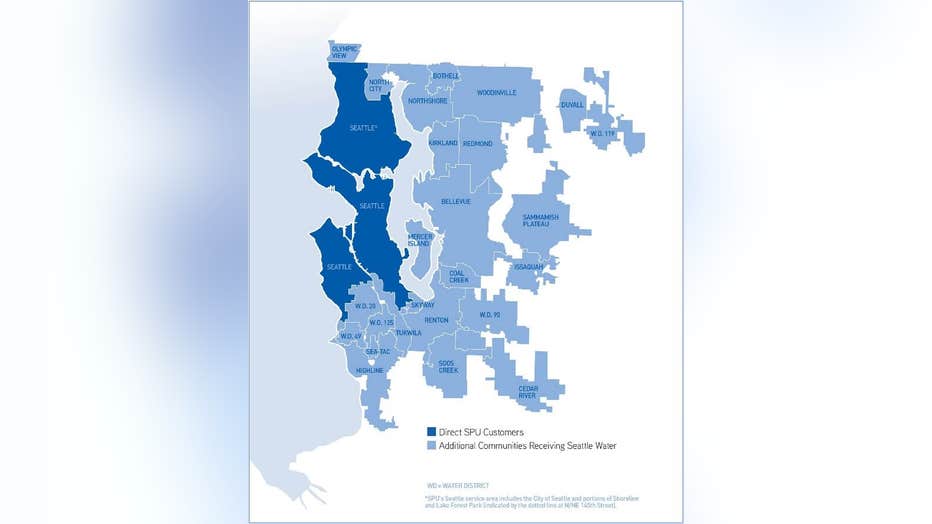Seattle reservoirs continue to drop as call continues to conserve water

Conserving water during the rainy season
Despite it being a wet week, 1.5 million people in our area are still being asked to conserve water.
SEATTLE - Rain continues to fall, but the reservoirs that hold 1.5 million people’s drinking water in and around the City of Seattle continues to drop.

(Seattle Public Utilities)
It’s been about two weeks since Seattle Public Utilities and 24 related utilities that work with them began asking customers to conserve water.
While the call has been public, and publicized across TV, print and radio not everyone is getting the message. In Seattle's Queen Anne neighborhood a majority of people FOX 13 News spoke with said they hadn’t heard about the call to conserve.
"I’m not surprised, but I haven’t heard anything about it," explained Becca Norris, one of a handful of people who were unaware of the current concern.
The overall amount of water being used on a daily basis has dropped since SPU enacted their call for voluntary water conservation, but looking at SPU data, there was a slight uptick in daily use week-to-week during the second week of their call to conserve. In their latest weekly snapshot SPU users were using 120 million gallons of water per day, the goal is to cut back to 100 million gallons a day.
"We need weeks and weeks, a months’ worth of rain, to really start to refill reservoirs," explained Kelly O’Rourke, a member of SPU’s water conservation team. "Our reservoirs that are lower than normal right now are going to go down even further, because we’re releasing even more water for fish. So, we realize it’s raining and we’re getting into fall, but we are still asking people to conserve water."

The Cedar River municipal watershed is typically low this time of year, however, the current level of water is roughly 20% lower than its historical average. While SPU consumers have dropped consumption since a voluntary call to conserve, the levels
Those releases for fish are required through agreements with state and federal agencies. If they didn’t release that water, it would threaten species our region relies on, including species like salmon that are threatened.
The concern is for the water level now, but also for the future. SPU is constantly modeling what their water situation looks like tomorrow, but also 4–5 months down the line.
Washington is entering an El Niño period, which typically comes with less precipitation.
As Washington’s state climatologist Nick Bond explains, the concern is that we’ll see a one-two punch. The first punch was an extremely dry summer that saw parts of Western Washington reach extreme drought stage. The second punch would be if precipitation falls as rain, rather than snow this winter, which would impact the snowpack that SPU relies on to refill its reservoirs to their peak levels during spring.
PREVIOUS COVERAGE: Washington state declares drought emergencies in a dozen counties
"Even though we’re called the Evergreen State, we definitely can have water shortages," said Bond. "Certainly there have been some significant impacts this year in terms of water supply, restrictions for agriculture. It also makes a difference for hydropower."
In the short-term, SPU is asking people to continue to cut back on water. It may seem crazy for locals who continue to see rain in the forecast, but it hasn’t been enough to catch up with the conditions we saw throughout summer.
In fact, SPU held back additional water earlier in the year in their reservoirs as they were concerned about the dry forecast. It helped, but the reservoirs that feed two-thirds of their consumers is still 20% lower than it typically is this time of year.
RELATED: Seattle Public Utilities asks its 1.5 million customers to 'voluntarily' reduce water use
If the reservoirs continue to drop in the coming weeks, it’s possible that pumps that sit in the Chester Morse reservoir would need to be turned on to ensure water is reaching its intended destination. Aside from maintenance and regular checks, those pumps haven’t been utilized since 2015, the last time SPU had to activate its water shortage contingency plan.
It’s a reminder that the current state of our area’s water supply isn’t cataclysmic, though it is rare, and things could get worse if locals don’t attempt to conserve.
"No matter how you use water, we’re asking people to think about it and pull back a little bit more, help us stretch this water supply," said O’Rourke.
There are a number of ways both residential water users, and businesses owners can reduce the amount of water they’re currently using to help SPU meet its current conservation goals until reservoirs are able to recover. You can find information, and infographics, on the SPU website.

